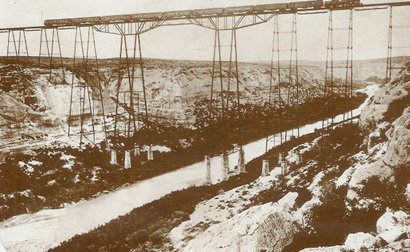|
|
Almost
everyone’s heard of Pecos Bill, the mythical West
Texas cowboy, but the “fair young” Pecos River Queen never
got the attention she deserves.
Her name, according to a century-old cowboy poem that commemorates
her, was Patty Moorehead.
First some background.
In
1892, about a decade after the Southern Pacific laid its tracks through
West Texas, the railroad
considerably shortened the route by building a huge bridge across
the lower Pecos.
That river -- Texas' westernmost if you don't count the Rio Grande
-- winds like a rattlesnake across West
Texas, emptying into Lake Amistad.
An engineering marvel, the Pecos River Viaduct (as it was formally
known) spanned 2,180 feet and towered 321 feet above the river. For
years, the metal structure ranked as the highest bridge in the United
States and the third highest in the world. Postcards of the bridge
became a favorite medium for the classic "Having a good time, wish
you were here" message. |
 |
Gutsy local cowboys,
confident they had a good horse and perhaps further emboldened by
a little whiskey, occasionally rode across the walkway that adjoined
the tracks on the bridge. There were no guardrails.
Naturally, any cowpoke who could walk his horse across a bridge taller
than a 32-story building earned quite a reputation. Such a fellow
would be a suitable partner for the Pecos River Queen, a gal as handy
at throwing a loop as she was pretty.
The
poem, long in the public domain, begins: |
Where the Pecos
River winds and turns in its journey to the sea,
From its white walls of sand and rock striving ever to be free,
Near the highest railroad bridge that all these modern times have
seen
Dwells fair young Patty Moorhead, the Pecos River Queen.
She's known by all the cowboys on the Pecos River wide;
They know full well that she can shoot, that she can rope and ride;
She goes to every round-up, every cow-work without fail,
Looking out for all her cattle branded ‘walking hog on a rail.’
She made her start in cattle, yes, made it with her rope;
Can tie down e'ry maverick 'fore it can strike a lope;
She can rope and tie and brand it as quick as any man;
She's voted by all cowboys an A-1 top cow-hand. |
N.
Howard “Jack” Thorp composed the poem in New Mexico in June 1901.
Including it in a book of poetry published seven years later, he noted,
“Written on Lower Pecos…
after Roy
Bean had told me of this fact concerning Patty.”
Thorp, a blue-blooded New Yorker who came west at 19 after a decline
in his family’s financial health, was referring to the infamous Judge
Roy Bean, the Law West of the Pecos. In truth, Bean
was just a boozy eccentric who made good newspaper and magazine copy.
Whether Patty was a fictional character dreamed up by Thorp has not
been proven or disproved, but there’s some evidence that she was for
real. The 1900 Del
Rio phone book does show a J.R. Moorehead as a cattle rancher
living in Comstock.
Patty might have been his daughter. And National Park Service historians
found that a Patty Moorehead Wilkins leased out some ranch
land near the Pecos High Bridge in the 1920s.
Thorp’s resume, however, is readily available. Born in New York in
1867, he came to New Mexico in 1886. An accomplished polo player and
horse trainer, he took to cowboying. He also did some civil engineering,
but the infrastructure he preferred was a good saddle.
In 1898, he pushed a herd from the territory to Higgins,
in the Texas Panhandle.
Along the way, he wrote a poem called “Little Joe, the Wrangler.”
It became a cowboy classic, later recorded to music.
Having an Eastern prep school education plus three years at Harvard,
Thorp was smart enough to realize the cowboy songs and poems he heard
around the campfire needed to be saved for posterity. He wrote them
down, added poems and songs of his own (including “The Pecos Queen”)
and published them in “Songs of the Cowboys” in 1908. An expanded
version of his book, with an introduction by Alice Corbin Henderson,
came out in 1921. It had more of his original material.
“‘Jack’ Thorp…is the genuine thing,” Henderson wrote. “He is an old-time
cattleman and cowpuncher, and his songs are the fruit of experience.
His gift is instinctive and naive, like that of all real cowboy poets,
and its charm is precisely in its fresh and ‘unliterary’ quality.”
The
last verse of Thorp’s poem tells the rest of Patty’s story: |
Across the Comstock
railroad bridge, the highest in the West,
Patty rode her horse one day a lover's heart to test;
For he told her he would gladly risk all dangers for her sake,
But the puncher wouldn't follow, so she's still without a mate. |
The old bridge
is gone, replaced by a
more modern span, but the poem about Patty endures. And, if the
Patty in the poem was Patty Moorehead Wilkins, she apparently did
finally find a fellow who measured up to her standards.
© Mike Cox
- April
30 , 2009 column
"Texas Tales"
|
|
|
